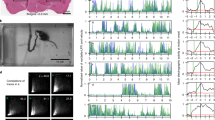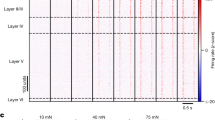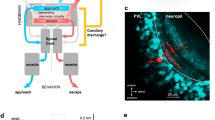Abstract
The response of the foot to touch during walking depends on whether it is in the air or on the ground. In most animals, reflex responses to external stimuli are similarly adapted to their timing in the locomotor cycle, but there is only fragmentary information about the neural mechanisms involved. In arthropods, reflex modulation can occur in the sensory receptors themselves1 and in neurons that discharge during locomotion2,3. By recording with dye-filled microelectrodes from neurons in the spinal cord of frog embryos, we describe reflex modulation at the level of sensory interneurons. Sensory inputs from skin receptors excite a specific class of spinal sensory interneuron whose activity leads to reflex bending of the body away from the stimulus. During swimming, these inputs are gated by rhythmic postsynaptic inhibition, so that sensory drive reaches motor neurons only at phases in the locomotor cycle when the resulting contraction would likewise turn the embryo away from the stimulated side. Such gating of sensory pathways could be a general feature of all locomotor systems where responses to sensory stimuli need to be adapted to the phase of locomotion.
This is a preview of subscription content, access via your institution
Access options
Subscribe to this journal
Receive 51 print issues and online access
$199.00 per year
only $3.90 per issue
Buy this article
- Purchase on Springer Link
- Instant access to full article PDF
Prices may be subject to local taxes which are calculated during checkout
Similar content being viewed by others
References
Sillar, K. T. & Skorupski, P. J. Neurophysiol. 55, 678–688 (1986).
Reichert, H. & Rowell, C. H. F. J. Neurophysiol. 53, 1201–1218 (1985).
Reichert, H., Rowell, C. H. F. & Gris, C. Nature 315, 142–144 (1985).
Clarke, J. D. W. & Roberts, A. J. Physiol., London. 354, 345–362 (1984).
Roberts, A., Dale, N., Evoy, W. H. & Soffe, S. R. J. Neurophysiol. 54, 1–10 (1984).
Roberts, A. & Clarke, J. D. W. Phil. Trans. R. Soc. Lond. B. 296, 195–212 (1982).
Clarke, J. D. W., Hayes, B. P., Hunt, S. P. & Roberts, A. J. Physiol., London. 348, 511–525 (1984).
Sillar, K. T. & Roberts, A. J. Neurosci. (in the press).
Dale, N. J. Physiol., London. 363, 61–70 (1985).
Dale, N., Ottersen, O. P., Roberts, A. & Storm-Mathisen, J. Nature 324, 255–257 (1987).
Kahn, J. A. & Roberts, A. Phil. Trans. R. Soc. Lond. B 296, 229–243 (1982).
Sillar, K. T. J. Physiol., London. 382, 181P (1986).
Roberts, A., Soffe, S. R. & Dale, N. in Neurobiology of Vertebrate Locomotion (eds Grillner, S. et al.) 279–306 (Macmillan, London, 1986).
Bässler, U. Biol. Cybern. 24, 47–49 (1976).
Skorupski, P. & Sillar, K. T. J. Neurophysiol. 55, 689–695 (1986).
Andersson, O., Forssberg, H., Grillner, S. & Lindquist, M. Brain Res. 149, 503–507 (1978).
Forssberg, H. J. Neurophysiol 42, 936–963 (1979).
Wallén, P. Expl Brain Res. 39, 193–202 (1980).
Grillner, S. in Handbook of Physiology Vol. 3. (ed. Brook, V.) 1179–1236 (American Physiological Society, Bethesda, 1981).
McClellan, A. D. & Grillner, S. Brain Res. 269, 237–250 (1983).
Crenna, P. & Friggo, C. Expl Neurol. 85, 336–345 (1984).
Belanger, M. & Patla, A. E. Neurosci. Lett. 19, 175–184 (1984).
Lennard, P. R. & Hermanson, J. W. Trends Neurosci. 8, 483–487 (1985).
Lennard, P. R. J. Neurosci. 5, 1434–1445 (1985).
Bayev, K. V. & Kostyuk, P. G. Neuroscience 7, 1401–1409 (1982).
Nieuwkoop, P. D. & Faber, J. Normal Tables of Xenopus laevis (Daudin) (North-Holland, Amsterdam, 1956).
Stewart, W. W. Cell 14, 741–751 (1978).
Author information
Authors and Affiliations
Rights and permissions
About this article
Cite this article
Sillar, K., Roberts, A. A neuronal mechanism for sensory gating during locomotion in a vertebrate. Nature 331, 262–265 (1988). https://doi.org/10.1038/331262a0
Received:
Accepted:
Issue Date:
DOI: https://doi.org/10.1038/331262a0
This article is cited by
-
A calibratable sensory neuron based on epitaxial VO2 for spike-based neuromorphic multisensory system
Nature Communications (2022)
-
Bioinspired multisensory neural network with crossmodal integration and recognition
Nature Communications (2021)
-
Corollary discharge across the animal kingdom
Nature Reviews Neuroscience (2008)
-
Roles for inhibition: studies on networks controlling swimming in young frog tadpoles
Journal of Comparative Physiology A (2008)
-
Cellular substrates of action selection: a cluster of higher-order descending neurons shapes body posture and locomotion
Journal of Comparative Physiology A (2008)
Comments
By submitting a comment you agree to abide by our Terms and Community Guidelines. If you find something abusive or that does not comply with our terms or guidelines please flag it as inappropriate.



